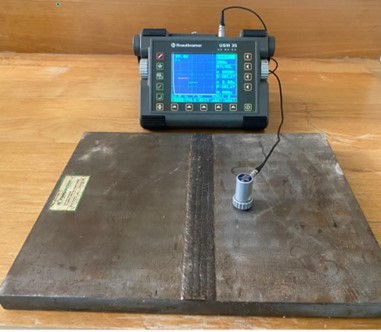About:
Ultrasonic Nondestructive Testing for Sustainable Construction Materials, From Recycled Fiber-Reinforced and 3D-Printed Mortars to Steel Plates and Pipes, this project explores innovative ways to enhance and monitor sustainable construction materials using advanced ultrasonic nondestructive testing (NDT) techniques. It integrates three complementary research thrusts: one focuses on recycled steel fiber–reinforced mortar, another develops a sustainable 3D-printable mortar incorporating fly ash, silica fume, and polypropylene fibers, and the third investigates conventional steel structural elements (such as steel plates and steel pipes) as additional linear construction materials in the study. In all cases, appropriate mechanical testing (e.g. compressive and flexural strength for mortars, and tensile or weld integrity tests for steel samples) is combined with cutting-edge ultrasonic methods: linear ultrasonic pulse velocity (UPV), nonlinear ultrasonic analysis (higher harmonic β index), and hybrid ultrasonic metrics (Sideband Peak Count Index, SPC-I, and Spectral Dissipation Index, SDI). This multi-parameter ultrasonic approach enables sensitive monitoring of each material’s internal microstructural integrity i.e. capturing strength development and microcrack formation in the cementitious mixes, and detecting incipient flaws or degradation in the steel components.
Scientific or Technical Area:
Advance Materials, Civil Engineering and Engineering Mechanics (Sustainable Construction Materials and Nondestructive Testing)
Project Timeline:
Indicate the start and end dates (January 2024 – Ongoing).
Main Objectives of the Project:
- Develop and optimize sustainable cementitious mortar mixtures including recycled steel fiber–reinforced mortars and 3D‑printable mortars with fly ash, silica fume, and polypropylene fibers to enhance mechanical performance and durability while reducing environmental impact.
- Apply advanced ultrasonic NDT techniques (linear UPV, nonlinear β-index, and hybrid indices SPC-I and SDI) to monitor the early-age development and long-term internal integrity of these innovative materials in real time, extending the monitoring framework to conventional steel elements (steel plates and pipes) as part of a comprehensive structural health monitoring strategy.
- Correlate ultrasonic parameters with mechanical performance (e.g. compressive and flexural strength for mortars, and defect severity or load-bearing capacity in steel components) to determine optimal material designs and validate these ultrasonic metrics as reliable indicators for quality control and structural health monitoring in sustainable construction.
Anticipated Impact and Relevance:
This project contributes to scientific advancement by bridging materials innovation with state-of-the-art ultrasonic monitoring across both novel and traditional construction materials. By integrating ultrasonic NDT into the study of green cementitious composites and conventional steel elements, it provides new insights into the relationship between microstructure and performance. The use of recycled steel fibers from waste tires and supplementary cementitious materials (fly ash, silica fume) directly addresses environmental and societal needs—turning industrial waste into value-added products and lowering the carbon footprint of construction.
The development of robust 3D-printable mortars and real-time quality assessment techniques supports the modernization of the construction industry, where additive manufacturing can lead to faster, more efficient building practices. Additionally, by including steel components in the NDT evaluation, the project extends its reach to structural health monitoring of entire structural systems. The same ultrasonic tools can detect early damage in metal elements (for instance, corrosion in a steel plate or incipient fatigue in a steel pipe), complementing their use on novel concretes and thus providing a holistic approach to infrastructure safety. Importantly, ensuring the structural integrity of both these new materials and conventional steel components through non-invasive testing will help engineers trust and adopt such technologies in critical infrastructure.
This aligns closely with national sustainability and innovation goals (such as Qatar National Vision 2030), which emphasize environmental protection, advanced technology adoption, infrastructure durability, and proactive maintenance. The project’s outcomes are poised to promote sustainable development by enabling long-lasting, low-carbon and safer infrastructure. Additionally, the research provides innovation and capacity-building: it involves collaboration among experienced researchers and early-career engineers, providing a platform for youth-led research and training in cutting-edge techniques. The project not only advances knowledge in material science and NDT, but also creates practical pathways for greener, safer, and smarter construction practices regionally and globally. It directly supports national strategies such as Qatar Vision 2030 and promotes innovation and youth-led research.
Supervisor(s) Details:
- Full Name: Prof. Dr. Mohammad Refa'at A. Rahim Irshidat
- Job Title/Position: Professor / Director
- Department or Unit: Center for Advanced Materials (CAM), NDT Unit
- Institution/Affiliation: Center for Advanced Materials (CAM), QU
- Email Address: mirshidat@qu.edu.qa
Team Members Involved:
- Dr. Umar Amjad, CAM, Qatar University
- Dr. Mohammad K. Abbas, CAM, Qatar University
- Dr. Mohammad Maqbool Ahmed, CAM, Qatar University
- Aemin Raqeeb, CAM, Qatar University
- Marwa Saadeh, CAM, Qatar University
Picture of the Prototype:
